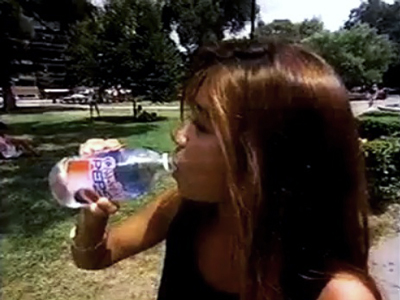This week, Pepsi announced that it was bringing back Crystal Pepsi, a popular drink from the 1990s, for one last time. But it’s hardly the first brand to bring back a product from the dead.
Appealing to nostalgia – that yearning for yesteryear – has emerged as a strategic and highly effective marketing technique in recent years, with marketers of all stripes rolling out comebacks for classic and retro products.
Here are some of the most welcome branded product comebacks in recent history:
1. Crystal Pepsi

Crystal Pepsi ruled the shelves in the U.S. in the early ’90s, but by 1994, the proliferation of countless copycats, including Coca-Cola’s Tab Clear, had saturated the colorless soda category.
Pepsi officially renewed the short-lived soda last summer, inspired by “overwhelming fan demand.” The brand had also offered Crystal Pepsi through a sweepstakes it held in 2015, but the 2016 initiative represented a broader retail push, for a limited time.
This summer, the soda will be returning to shelves "for one final time," according to Pepsi, becoming available widely on August 14.
2. Coca-Cola Surge

Coca-Cola originally introduced Surge in 1996, but took it off the market in 2003. After a successful year-long pilot program on Amazon, the company re-introduced the product -- created in the 1990s to compete with Pepsi's Mountain Dew - across select stores in 2015.
The comeback was in response to a huge fan movement online called the Surge Movement, which lobbied for the company to bring back their favorite drink. The brand eventually listened, using the relaunch as an opportunity to not just appeal to past consumers, but also recruit new fans through the soda's engaged and passionate Facebook group community.
"Surge superfans have amazing stories to tell and have been so instrumental in bringing back Surge," said Kimberly Paige, vice president, Sprite and Flavors, Coca-Cola North America. "But younger, variety-seeking consumers are also intrigued by this brand because to them it's new and different."
3. MillerCoors Zima

Zima was also a part of the "clear craze" of the 1990s, in the ranks of Crystal Pepsi and Tab Clear - except with an alcoholic kick. The clear malt liquor from MillerCoors hit the market in 1993, enjoyed a swift rise and then faded into eventual oblivion, being pulled off from shelves in 2008. It returned to stores this July 4 weekend for a limited time.
Zima's return comes on the heels of a resurgence in the alcoholic soda category in recent years, with brands including Mike's Hard Lemonade and AB InBev's Best Damn Cherry Cola leading the charge.
The comeback is an obvious nostalgia play for the brand, with the ad campaign touting its return full of '90s references -- everything from Jnco jeans to frosted tips.
4. Nokia 3310

There's no way that you, or your mom, or your sister, or at least your uncle have not owned this handset at some point.
Nokia's new licensee HMD Global paid homage to the former phone giant by making a nostalgia play and relaunching one of its most iconic products -- the Nokia 3310 -- this year. The almost-indestructible device was first released back in 2000, and went on to sell a staggering 126 million units.
The same company that manufactures the iPhone, Foxconn, is manufacturing the revamped 3310.
5. SodaStream

You may never have heard of SodaStream before Scarlett Johansson, but the machine was pretty popular in the '80s.
It faded into obscurity by the mid '90s, until Israeli firm breathed a new lease of life into it and relaunched upgraded versions of the original SodaStream machine in 41 countries.
6. Steve Madden Slinky

This April, Steve Madden re-released these iconic flatform slides, the ubiquitous style statement of a whole generation of teenage girls in the 1990s.
The new Slinky does come with some practical adjustments. While the classic sandal had a chunky heel and stitching on the sole, the new version features a flat-bottom platform and smooth sole.
7. Levi's 505

They say denim never goes out of style. Levi's resurrected its popular style from the 1960s, the 505, on its 50th anniversary last year. The style was first launched in 1967, and enjoyed its heyday during the height of the counterculture movement in San Francisco.
The relaunch was fueled by customers' increased interest in buying vintage pairs of the original style, Jonathan Cheung, the brand's senior vice president of global design, told WWD. the brand remained so true to the original that it recreated it to the last detail - even tracking down the original fabric mill to reproduce the specific denim material.
8. Nintendo Game Boy

You cannot call yourself a 1990s kid if you did not spend hours playing Tetris and Super Mario on the Nintendo Game Boy. The console was ridiculously popular, and sold a whopping 118 million units.
The Game Boy disappeared in 2003, but is all set to make a comeback next month, thanks to a company called Retro-Bit, which is reviving it.
9. Polaroid

Polaroid has seen its fair share of ups and downs, particularly since the advent of digital cameras. The brand was forced to file for bankruptcy twice between 2001 and 2009, and go through a roster of six CEOs between 2005 and 2009. But going back to the basics has been a key factor in its revival.
In 2009, Polaroid revived the OneStep -- a classic camera that also doubled as America's best-selling camera in 1977. It sold the camera as part of a limited edition kit priced at $450, and subsequently introduced a number of retro-inspired cameras fit for the digital age.
The Polaroid Pic-300, for example, is a modern spin on the classic Polaroid camera and instantly prints wallet-size photographs. The Polaroid Z2300, on the other hand, successfully merges analog and digital photography, and lets users instantly print photographs as well as save them as digital files.
10. Mad Libs

In 2009, Penguin, realized the timelessness of its classic fill-in-the-blank game Mad Libs, and decided to adapt it into an interactive app. For the brand, it was not only the perfect opportunity to take Gen-Xers on a trip down memory lane, but also introduce the brand to a new batch of digital natives.
After its first iteration, it reworked the app in 2014. The brand brought Phil N. DeBlanks - the googly-eyed, smiley-faced doodle on every Mad Libs book - to life within the app, reimagining him as a coach and even a friend to players. He giggles when users type in a funny word, for example.
According to Penguin, Mad Libs sales increased 74 percent and the app had been downloaded over 5.5 million times between 2009 and early 2015.

